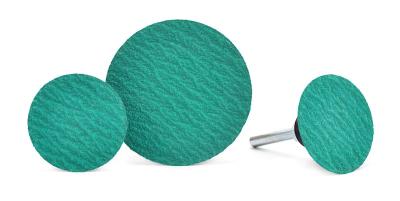
Superior Abrasives, LLC introduces SHUR-KUT® Zirconia Grinding Aid Quick Change Discs feature long lasting, durable grains and sharp cutting action for extended stock removal with low heat generation. This cooler cut reduces friction and premature breakdown of grains and backing, for longer disc life. A hybrid grain exposes a fresh cutting edge during use, for aggressive grinding on stainless steel and exotic alloys, as well as ferrous and non-ferrous materials. SHUR-KUT® Zirconia Grinding Aid Quick Change Discs are ideal for general purpose grinding and stock removal, deburring or parting line removal on cast parts, spot weld removal and blending, mold and cavity grinding and refurbishing, grinding and preparing hot castings, and more.
They are available for type S or Type R, in 1 ½”, 2” and 3” diameters for use with right angle die grinders. Grits available from 36 to 120, with optimal speeds of 7,000 to 13,000 RPM, and maximum speeds from 20,000 to 30,000 RPM.
In addition to Zirconia, SHUR-KUT® Quick Change Discs are also available with Ceramic and Aluminum Oxide grinding aids to suit a wide variety of applications. Regardless of material, the addition of grinding aids significantly reduces heat for extended disc life.
With a smaller diameter, quick change discs provide ease of use on intricate parts and excellent control when shaping or blending surface portions, especially on flat surfaces. Moderate flexibility of quick change discs and their holders allows contouring and access to inner corners. These unique quick change functionality reduces changeover downtime and eases transitions between grit, material, or even abrasive type where multi-step processes are required.
Contact Details
Related Glossary Terms
- abrasive
abrasive
Substance used for grinding, honing, lapping, superfinishing and polishing. Examples include garnet, emery, corundum, silicon carbide, cubic boron nitride and diamond in various grit sizes.
- alloys
alloys
Substances having metallic properties and being composed of two or more chemical elements of which at least one is a metal.
- aluminum oxide
aluminum oxide
Aluminum oxide, also known as corundum, is used in grinding wheels. The chemical formula is Al2O3. Aluminum oxide is the base for ceramics, which are used in cutting tools for high-speed machining with light chip removal. Aluminum oxide is widely used as coating material applied to carbide substrates by chemical vapor deposition. Coated carbide inserts with Al2O3 layers withstand high cutting speeds, as well as abrasive and crater wear.
- backing
backing
1. Flexible portion of a bandsaw blade. 2. Support material behind the cutting edge of a tool. 3. Base material for coated abrasives.
- flat ( screw flat)
flat ( screw flat)
Flat surface machined into the shank of a cutting tool for enhanced holding of the tool.
- grinding
grinding
Machining operation in which material is removed from the workpiece by a powered abrasive wheel, stone, belt, paste, sheet, compound, slurry, etc. Takes various forms: surface grinding (creates flat and/or squared surfaces); cylindrical grinding (for external cylindrical and tapered shapes, fillets, undercuts, etc.); centerless grinding; chamfering; thread and form grinding; tool and cutter grinding; offhand grinding; lapping and polishing (grinding with extremely fine grits to create ultrasmooth surfaces); honing; and disc grinding.
- parting
parting
When used in lathe or screw-machine operations, this process separates a completed part from chuck-held or collet-fed stock by means of a very narrow, flat-end cutting, or parting, tool.
- shaping
shaping
Using a shaper primarily to produce flat surfaces in horizontal, vertical or angular planes. It can also include the machining of curved surfaces, helixes, serrations and special work involving odd and irregular shapes. Often used for prototype or short-run manufacturing to eliminate the need for expensive special tooling or processes.
